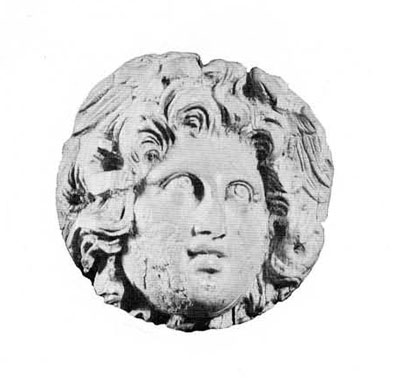 Of all the sculptural work of Greek antiquity, that in ivory is among the least well known to us from preserved examples, although the fame of Greek work in ivory has come down to us abundantly in literature. Ivory itself endures well, but burial in damp earth has caused most Greek carvings in this material to crack and split into small, unrecognizable fragments along the lines of the natural growth of the tusks from which they were cut. It is this an especial pleasure to be able to illustrate here with the kind of permission of its owner, Mr. Walter Stuempfig, an ivory medallion of Greek workmanship in an almost complete state of preservation.
Of all the sculptural work of Greek antiquity, that in ivory is among the least well known to us from preserved examples, although the fame of Greek work in ivory has come down to us abundantly in literature. Ivory itself endures well, but burial in damp earth has caused most Greek carvings in this material to crack and split into small, unrecognizable fragments along the lines of the natural growth of the tusks from which they were cut. It is this an especial pleasure to be able to illustrate here with the kind of permission of its owner, Mr. Walter Stuempfig, an ivory medallion of Greek workmanship in an almost complete state of preservation.
The head depicted in high relief is that of a mythological creature, the Gorgon Medusa, for in her hair above, at the base of the supernatural, unfurled wings, small heads of snakes peer out; another snake is seen at cheek level to the side, its coils encircling her chin. The medallion, 2 1/8 inches in diameter, was once attached as an applique to some piece of furniture, a throne, a couch, or a coffin. Its flat back surface has a large central drill hole to receive a peg, is scored for the better purchase of some kind of adhesive, and has two small nail holes piercing the hair above to ensure an upright position.
When we recall that ivory in Greek sculpture was often employed in conjunction with gold, the ivory used for faces and exposed flesh, the gold for garments, it is perhaps not surprising to see in this head indications of methods of carving normal in metalwork. The engraved eye and pupil, which in stone sculpture are an indication of advanced Roman date, are often enough employed in gold, silver, and bronze work of far earlier times.
The excellent preservation of the medallion alone indicates that it was buried in some dry climate such as that of Egypt, and its provenience is in fact stated to be Alexandria, one of the great centers of Greek artistic production in the Hellenistic period, the three hundred years following the city’s foundation by Alexander the Great in 332 B.C. It seems likely that this head was made there in these years, attached to grave furniture, and so preserved. From it, though modest in scale and use, we gain new insight into lost major sculpture in which sculptors employed ivory for the features of divinities they delighted to honor since its luminous quality, delicately tinted, conveyed not only the closest resemblance to the glow of human flesh but the unearthly light of immortality as well.
